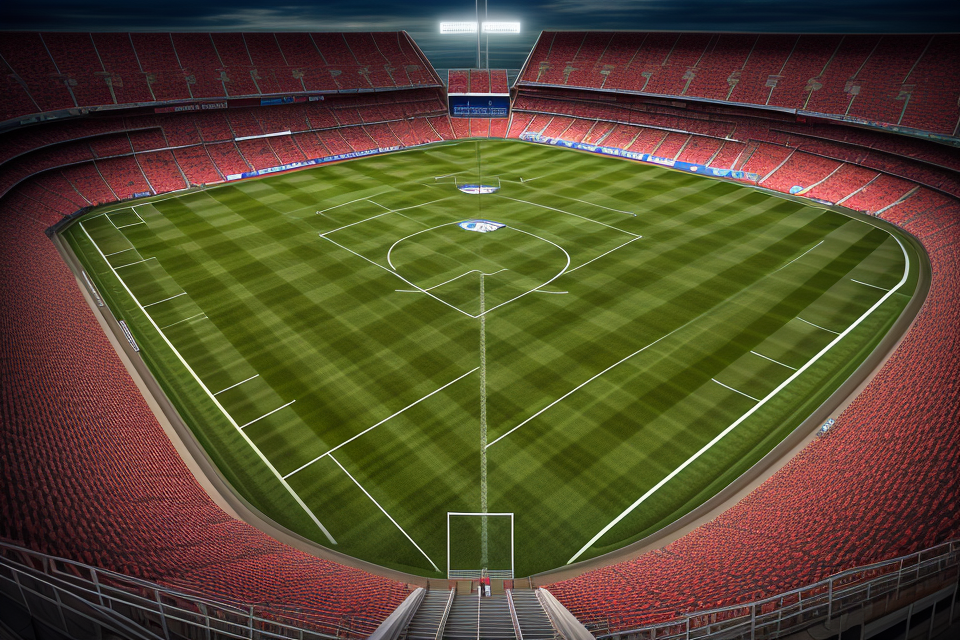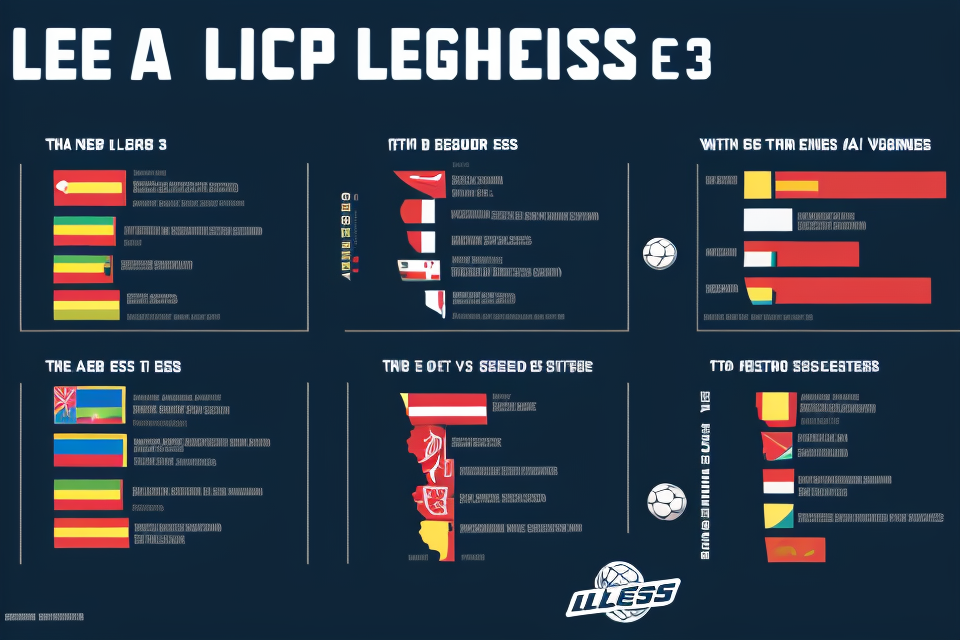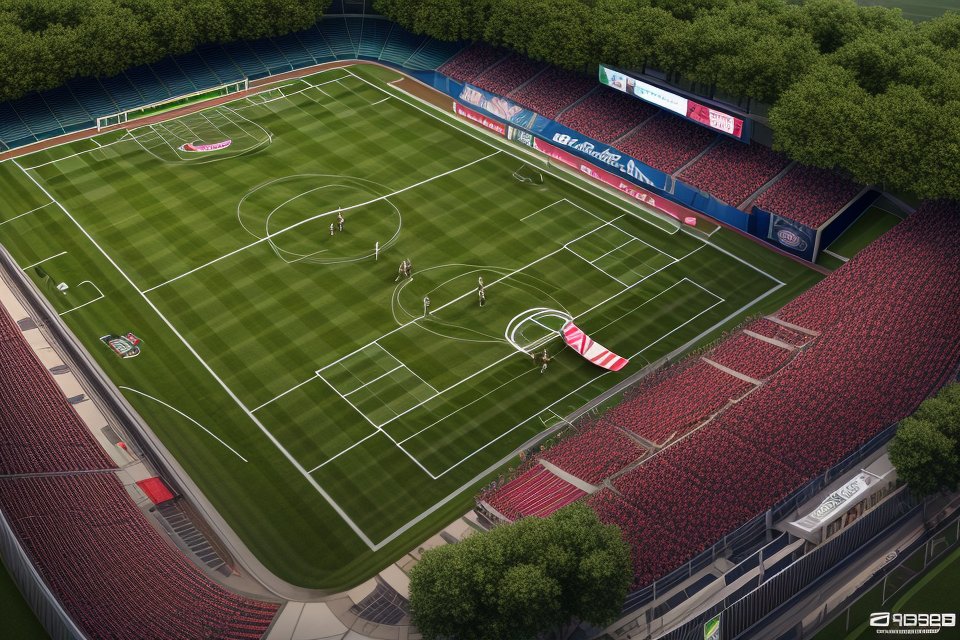Welcome to the world of football, where the Premier League reigns supreme. But what lies beneath the glitz and glamour of the top tier? Join us as we explore the football pyramid and uncover the leagues that make up the beautiful game below the Premier League. From the second tier of English football to the National League, we’ll delve into the rich history and drama of the leagues that are the lifeblood of the sport. Get ready to discover the stories and characters that make up the football pyramid, and find out what it takes to climb the ladder of success in the beautiful game.
The Basics of the Football Pyramid
What is the Football Pyramid?
The football pyramid is a term used to describe the hierarchical structure of English football leagues. It is a system that encompasses several tiers of football leagues, with each tier representing a level of competition. The pyramid is designed in such a way that there is a clear promotion and relegation system between the different tiers, allowing teams to move up or down based on their performance on the field.
The football pyramid is an important aspect of the English football league system because it provides a clear pathway for teams to progress through the ranks and achieve their goals. It also ensures that there is a level playing field for all teams, regardless of their size or financial resources. The pyramid is divided into several levels, with each level representing a different tier of competition. The highest level of the pyramid is the Premier League, followed by the English Football League (EFL), National League, and then the various regional leagues.
In summary, the football pyramid is a critical component of the English football league system. It provides a clear pathway for teams to progress through the ranks and ensures that there is a level playing field for all teams. By understanding the basics of the football pyramid, fans and players alike can gain a better appreciation for the sport and the challenges faced by teams at all levels of competition.
Premier League: The Top Tier
Overview of the Premier League
The Premier League is the highest tier of professional football in England. It was formed in 1992, after the decision to break away from the Football League, and has since become one of the most popular and lucrative sports leagues in the world. The Premier League is composed of 20 teams, who compete against each other throughout the season, with the top four teams qualifying for the UEFA Champions League, and the fifth-placed team qualifying for the UEFA Europa League.
Importance and prestige of playing in the Premier League
Playing in the Premier League is considered the pinnacle of achievement for any English football club. The Premier League is renowned for its competitiveness, with every team having a genuine chance of winning the title, and its global reach, with millions of fans tuning in to watch matches from around the world. The Premier League also offers substantial financial rewards, with the television rights fees and sponsorship deals providing a significant source of income for the participating clubs. As a result, winning promotion to the Premier League is often seen as the ultimate goal for many football clubs, and the competition to achieve this is fierce.
The Football League: Below the Premier League
The Football League is the league that sits below the Premier League in the English football pyramid. It is a league that consists of three divisions, with each division having its own set of teams that compete against each other throughout the season. The three divisions within the Football League are known as League One, League Two, and the Championship.
Each division within the Football League has its own set of rules and regulations that teams must abide by. For example, in League One and League Two, teams must have a minimum of 11 players on the field at all times, while in the Championship, teams must have a minimum of 11 players on the field, plus up to three additional players who are designated as substitutes.
The teams that compete in the Football League are not just limited to English teams, but also include teams from Wales. In fact, some of the most successful teams in the Football League are Welsh teams, such as Cardiff City and Swansea City.
In addition to the three divisions within the Football League, there are also several regional leagues that sit below the Football League. These leagues include the National League, the National League North and South, and the Northern Premier League. Teams that compete in these leagues are generally smaller clubs that have not yet been able to break into the Football League.
Overall, the Football League is a vital part of the English football pyramid, providing a platform for teams to compete against each other and strive for promotion to the Premier League.
National League: Level 5
The National League, also known as Level 5, is the fifth tier of the English football league system. It is the first level of the football pyramid that is not part of the Football League (EFL) and is made up of two divisions: National League North and National League South.
- Definition and explanation:
The National League is a competition for teams that have been relegated from the EFL or have been promoted from the National League North and South divisions. It is the highest level of non-league football in England and is known for its competitive nature and high-quality football. - Consists of two divisions: National League North and National League South:
The National League North and South divisions are the two divisions that make up the National League. They are made up of teams that have been relegated from the EFL or have been promoted from the regional leagues at Level 8 and 9. These divisions are known for their competitive nature and are often seen as a stepping stone for teams looking to reach the EFL.
Regional Leagues: Levels 6-8
The regional leagues make up the sixth to eighth tiers of the English football pyramid. These leagues are made up of various regional divisions, each with their own unique name and structure.
Definition and Explanation
The regional leagues are a crucial part of the football pyramid, as they provide the opportunity for teams to progress through the levels and potentially reach the higher tiers of the game. These leagues are divided into various divisions, with each division representing a different level of football within the regional league system.
Consists of Various Regional Leagues
Some of the most well-known regional leagues include the Northern Premier League, Southern League, and Isthmian League. These leagues are made up of teams from specific regions of the country and provide a platform for them to compete against each other at a high level.
Northern Premier League
The Northern Premier League is one of the most prestigious regional leagues in the country. It is made up of teams from the North and North-East of England and is divided into two divisions, the Premier Division and the Division One. The league is known for its high level of competition and has produced many successful teams over the years.
Southern League
The Southern League is another well-known regional league, made up of teams from the South and South-West of England. It is divided into two divisions, the Premier Division and the Division One, and is known for its strong competition and talented teams.
Isthmian League
The Isthmian League is a regional league made up of teams from London and the South-East of England. It is divided into two divisions, the Premier Division and the Division One, and is known for its high level of competition and talented teams.
In conclusion, the regional leagues are a crucial part of the football pyramid, providing opportunities for teams to progress through the levels and potentially reach the higher tiers of the game. With their high level of competition and talented teams, the Northern Premier League, Southern League, and Isthmian League are some of the most well-known and respected regional leagues in the country.
Local Leagues: Levels 9-10
Local leagues at levels 9-10 form the bottom tier of the English football pyramid. These leagues are composed of various local teams that compete against each other throughout the football season. In this section, we will take a closer look at these local leagues and what they entail.
Definition and Explanation
Local leagues at levels 9-10 are the eighth tier of the English football pyramid. They are composed of various local teams that compete against each other throughout the football season. These leagues are the bottom tier of the football pyramid and are often referred to as grassroots football.
Consists of Various Local Leagues
There are several local leagues that make up levels 9-10 of the English football pyramid. Some of the most notable local leagues include the Combined Counties League and the Wessex League.
Combined Counties League
The Combined Counties League is a local league that is made up of teams from Berkshire, Buckinghamshire, and Surrey. The league was founded in 1991 and currently has three divisions, with each division containing between 14-16 teams. The league is known for its competitive nature and has produced several teams that have gone on to compete at higher levels of the football pyramid.
Wessex League
The Wessex League is another local league that is made up of teams from the South West of England. The league was founded in 1984 and currently has three divisions, with each division containing between 14-16 teams. The league is known for its high level of competitiveness and has produced several teams that have gone on to compete at higher levels of the football pyramid.
Overall, local leagues at levels 9-10 of the English football pyramid are the bottom tier of the pyramid and are composed of various local teams that compete against each other throughout the football season. These leagues are the grassroots of English football and are the starting point for many teams that aspire to compete at higher levels of the pyramid.
Non-League Football: Below Local Leagues
Non-league football refers to the level of football that exists below the local leagues. These clubs play in various cup competitions such as the FA Vase and FA Trophy, and their level of play is often considered to be below that of the professional leagues.
Non-league football is the term used to describe the level of football that is played outside of the professional leagues. These clubs are often comprised of amateur players who have day jobs and play football as a hobby. The level of play is often considered to be lower than that of the professional leagues, but it is still highly competitive and attracts a dedicated following of fans.
Consists of Various Non-League Clubs
Non-league football is made up of a large number of clubs that play at various levels. These clubs are often based in smaller towns and cities, and they compete in various cup competitions throughout the year. Some of the most prestigious non-league competitions include the FA Vase and the FA Trophy, which are both national cup competitions that attract a large number of fans and media attention.
Other Cup Competitions
In addition to the FA Vase and FA Trophy, there are a number of other cup competitions that non-league clubs can compete in. These include the FA Cup, which is the most prestigious cup competition in English football and is open to all teams, regardless of their level of play. Other competitions include the League Cup, which is a national cup competition for teams in the professional leagues, and the Johnstone’s Paint Trophy, which is a regional cup competition for teams in the lower leagues.
Lower Level of Play
Non-league football is often considered to be a lower level of play than that of the professional leagues. The level of skill and competition is generally lower, and the stadiums are often smaller and less well-equipped. However, despite the lower level of play, non-league football remains highly competitive and attracts a dedicated following of fans who are passionate about their clubs.
Understanding the Structure of Non-League Football
How Non-League Football Works
Non-league football, also known as football outside of the Premier League, is a complex and intricate network of clubs, leagues, and competitions. To understand how non-league football works, it is important to consider the following aspects:
The Football Association (FA)
The Football Association (FA) is the governing body of football in England, and it oversees all levels of the sport, including the Premier League and non-league football. The FA is responsible for setting the rules and regulations for all football competitions in England, and it also has the power to sanction clubs and individuals who violate these rules.
The Football Pyramid
The football pyramid is a hierarchical structure that represents the different levels of football in England. The pyramid is made up of four levels: the Premier League, the English Football League (EFL), the National League, and the regional leagues. Clubs at the top of the pyramid have the most resources and attract the most attention, while clubs at the bottom of the pyramid struggle to survive on limited budgets and resources.
Club Structure
Non-league clubs are typically run by volunteers or small groups of people, and they often rely on fundraising and sponsorship to stay afloat. Clubs at the top of the non-league pyramid may have full-time staff and professional players, while clubs at the bottom of the pyramid may have only a handful of part-time players and no full-time staff.
Leagues and Competitions
Non-league football is made up of a network of leagues and competitions, each with its own set of rules and regulations. The top level of non-league football is the National League, which is divided into two divisions: the National League North and the National League South. Below the National League, there are several regional leagues, such as the Isthmian League, the Northern Premier League, and the Southern League. These leagues are further divided into divisions and sub-divisions, depending on the level of the clubs involved.
In addition to league competitions, there are also several cup competitions for non-league clubs, including the FA Cup, the FA Trophy, and the FA Vase. These competitions are open to all non-league clubs, and they provide an opportunity for smaller clubs to achieve national recognition and even win major trophies.
Overall, non-league football is a complex and diverse world that offers opportunities for players and fans alike. Whether you are a fan of a top-flight Premier League club or a supporter of a small non-league club, there is something for everyone in the world of football.
The FA Vase and FA Trophy
The FA Vase and FA Trophy are two of the most prestigious non-league cup competitions in England. These competitions are open to teams playing at Levels 8 and below of the English football league system. The FA Vase is open to teams playing in the Southern League, Eastern Counties League, and the Middlesex Senior Cup, while the FA Trophy is open to teams playing in the Northern Premier League, Southern League, and the Isthmian League.
These competitions are significant because they provide an opportunity for non-league teams to compete against each other and gain recognition outside of their local leagues. The FA Vase and FA Trophy are also important because they offer a chance for lower-level teams to achieve national recognition and even reach the final at Wembley Stadium, which is a dream for many non-league players.
In addition to providing an opportunity for non-league teams to compete against each other, the FA Vase and FA Trophy also offer prize money to the winners and runners-up, which can be a significant financial boost for smaller clubs. These competitions also attract attention from fans of higher-level teams, who may be interested in watching potential future stars in action.
Overall, the FA Vase and FA Trophy are important competitions in non-league football that offer opportunities for teams to compete against each other, gain recognition, and even win prize money. These competitions are an essential part of the football pyramid and play a crucial role in the development of non-league football in England.
Promotion and Relegation in Non-League Football
Promotion and relegation are fundamental principles in the English football league system. They determine the movement of teams between different divisions and are essential to understanding the structure of non-league football. In this section, we will delve into the rules and significance of promotion and relegation in non-league football.
How promotion and relegation works in non-league football
Non-league football in England is made up of multiple divisions, each with its own set of leagues. The highest division is the National League, followed by the National League North and South, and then several regional leagues. Promotion and relegation work differently depending on the division.
In the National League, the top team is promoted to the National League, while the bottom team is relegated to the National League North or South. The same applies to the National League North and South, where the top team is promoted to the National League, and the bottom team is relegated to the regional leagues.
In the regional leagues, promotion and relegation are less structured. Teams are promoted based on their performance and may be promoted to a higher division within the regional league or to a division in another region. Relegation is also determined by performance, and teams may be relegated to a lower division within the regional league or to a lower division in another region.
Significance and importance of promotion and relegation in non-league football
Promotion and relegation are essential to the structure of non-league football because they create a clear pathway for teams to progress through the leagues. They provide a sense of competition and motivation for teams to perform well, knowing that their performance could lead to promotion or relegation.
Furthermore, promotion and relegation ensure that teams are placed in leagues that are appropriate for their skill level. Teams that perform well in their division have the opportunity to move up to a higher division, while teams that struggle may be relegated to a lower division. This ensures that the leagues are competitive and that teams are challenged at an appropriate level.
Overall, promotion and relegation are critical components of the non-league football structure. They create a sense of competition, motivation, and ensure that teams are placed in appropriate divisions based on their performance.
Amateur Football
Amateur football, also known as non-league football, is a level of football that is played outside of the professional leagues. Unlike professional football, amateur football is played for the love of the game rather than for financial gain. The primary difference between amateur and professional football is that amateur players do not receive payment for their participation in the sport.
In amateur football, players typically play for local clubs or teams, and matches are usually played on weekends. The games are usually less intense and less physically demanding than professional football matches, but they still require a high level of skill and fitness.
One of the key benefits of amateur football is that it provides an opportunity for players to develop their skills and gain experience without the pressure of professional competition. Additionally, amateur football often serves as a stepping stone for aspiring professional players, who use their performances in amateur leagues to attract the attention of professional scouts and coaches.
Overall, amateur football is an important part of the football pyramid, providing a pathway for talented players to develop their skills and pursue their dreams of playing at the highest level.
FAQs
1. What is the football pyramid?
The football pyramid is a hierarchical structure that represents the various levels of football leagues in a country. In England, the football pyramid consists of the Premier League, the English Football League (EFL), and the National League System (NLS).
2. What is the Premier League?
The Premier League is the highest level of professional football in England. It consists of 20 teams that compete against each other throughout the season. The Premier League is widely considered to be one of the best football leagues in the world, attracting some of the biggest names in the sport.
3. What is below the Premier League?
Below the Premier League, there are several tiers of football leagues. The English Football League (EFL) is the second tier of professional football in England, consisting of three divisions: the Championship, League One, and League Two. Below the EFL, there are several regional football leagues that make up the National League System (NLS).
4. What is the National League System (NLS)?
The National League System (NLS) is a network of regional football leagues that sit below the English Football League (EFL). The NLS is made up of several divisions, with the lowest division being the Northern Premier League Division One South East. From there, the leagues progress upwards through the pyramid, with each division feeding into the one above it.
5. How do teams get promoted to the Premier League?
Teams can get promoted to the Premier League by winning their respective league or by winning the playoffs. For example, the Championship winner is automatically promoted to the Premier League, while the teams that finish in second, third, and fourth place in the Championship play off against each other to determine the third and fourth promoted teams.
6. How do teams get relegated from the Premier League?
Teams are relegated from the Premier League at the end of each season based on their final position in the table. The three teams that finish in the bottom three positions are relegated to the Championship.
7. How many teams are in each league of the football pyramid?
The number of teams in each league of the football pyramid varies. The Premier League has 20 teams, the Championship has 24 teams, League One has 24 teams, and League Two has 24 teams. The National League System (NLS) is made up of several divisions, with each division having varying numbers of teams.
8. Can teams from the same city play in different leagues of the football pyramid?
Yes, teams from the same city can play in different leagues of the football pyramid. For example, Arsenal and Tottenham Hotspur are both based in London and play in the Premier League, while Leyton Orient and Dagenham & Redbridge are based in London and play in the National League.
9. What is the difference between the Premier League and the EFL?
The Premier League is the top tier of professional football in England, while the EFL is the second tier. The Premier League is made up of 20 teams that compete against each other throughout the season, while the EFL is made up of three divisions with a total of 64 teams. The Premier League also has greater financial resources and higher profile than the EFL.



